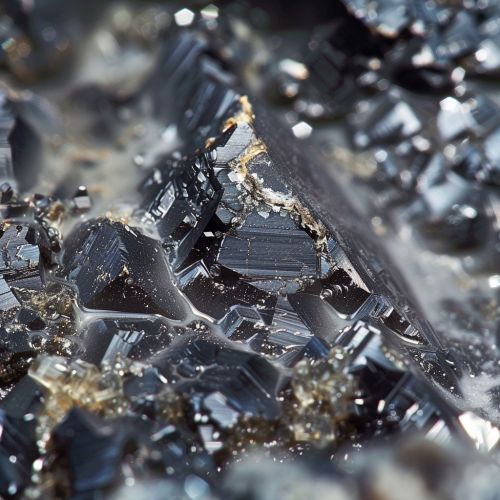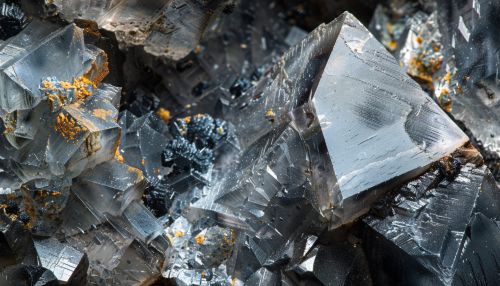Melt rock
Introduction
Melt rock, also known as impact melt rock, is a type of rock that forms as a result of the melting and subsequent solidification of material due to the intense heat and pressure generated by a meteorite impact. This process involves the melting of target rocks at the site of impact, which then cool and crystallize to form new rock types. Melt rocks are significant in the study of planetary geology and impact cratering processes, as they provide insights into the conditions and materials involved in such high-energy events.
Formation Process
The formation of melt rock begins with the impact of a meteorite on the surface of a planetary body. The kinetic energy of the meteorite is converted into thermal energy upon impact, generating extreme temperatures and pressures. This leads to the melting of the target rocks, which can include a variety of lithologies such as basalt, granite, and sedimentary rocks. The molten material, often referred to as impact melt, can be ejected from the crater or remain within it, depending on the dynamics of the impact event.
During the cooling process, the melt can crystallize to form a variety of textures and mineral assemblages. The cooling rate and the composition of the melt play crucial roles in determining the final characteristics of the melt rock. Rapid cooling can result in the formation of glassy textures, while slower cooling allows for the growth of larger crystals.
Characteristics of Melt Rock
Melt rocks exhibit a range of physical and chemical characteristics that reflect their formation history. These characteristics include:
Texture
The texture of melt rocks can vary widely, from fine-grained glassy textures to coarse-grained crystalline textures. The presence of quenched glass indicates rapid cooling, while the development of crystalline phases suggests slower cooling rates. Melt rocks may also exhibit flow structures, vesicles, and brecciation due to the dynamic nature of the impact process.
Mineralogy
The mineral composition of melt rocks is influenced by the composition of the target rocks and the degree of mixing during the melting process. Common minerals found in melt rocks include plagioclase, pyroxene, olivine, and quartz. Accessory minerals such as zircon and apatite can also be present, providing valuable information about the conditions of formation.
Geochemistry
Geochemical analysis of melt rocks can reveal important information about the impact event and the target rocks. Elements such as nickel, chromium, and iridium can be enriched in melt rocks, indicating the contribution of meteoritic material. Isotopic studies can also provide insights into the age and provenance of the melt rocks.
Occurrences of Melt Rock
Melt rocks are found at impact craters on Earth and other planetary bodies, such as the Moon and Mars. Notable examples include:
Earth
On Earth, melt rocks have been identified at several well-known impact structures, including the Chicxulub crater in Mexico, the Sudbury Basin in Canada, and the Vredefort crater in South Africa. These sites provide valuable opportunities to study the effects of large impacts on the Earth's crust and the formation of melt rocks.
Moon
The Moon's surface is covered with numerous impact craters, many of which contain melt rocks. The Apollo missions returned samples of lunar melt rocks, which have been extensively studied to understand the Moon's impact history and geological evolution. Lunar melt rocks often exhibit high levels of shock metamorphism and unique mineralogical features.
Mars
Impact craters on Mars also contain melt rocks, which have been studied using data from orbiters and rovers. Martian melt rocks provide insights into the planet's impact history and the composition of its crust. The study of Martian melt rocks is crucial for understanding the geological processes that have shaped the planet's surface.
Importance in Planetary Science
Melt rocks play a significant role in planetary science and the study of impact cratering processes. They provide valuable information about the conditions and materials involved in impact events, which can help scientists understand the history and evolution of planetary surfaces. The study of melt rocks also contributes to our knowledge of shock metamorphism, crater formation, and the distribution of meteoritic material.
Analytical Techniques
Several analytical techniques are used to study melt rocks, including:
Petrography
Petrographic analysis involves the examination of thin sections of melt rocks under a microscope to determine their mineralogical and textural characteristics. This technique provides detailed information about the crystallization history and cooling rates of the melt rocks.
Geochemical Analysis
Geochemical techniques, such as X-ray fluorescence (XRF) and inductively coupled plasma mass spectrometry (ICP-MS), are used to determine the elemental composition of melt rocks. These analyses can reveal the presence of meteoritic material and provide insights into the mixing processes during impact events.
Isotopic Analysis
Isotopic studies, including radiometric dating and stable isotope analysis, are used to determine the age and provenance of melt rocks. These techniques can provide information about the timing of impact events and the sources of the materials involved.
Electron Microprobe
The electron microprobe is used to analyze the chemical composition of individual minerals within melt rocks. This technique provides high-resolution data on the distribution of elements within the minerals, which can be used to infer the conditions of formation.
Conclusion
Melt rocks are a fascinating and important component of planetary geology, providing valuable insights into the processes and conditions involved in impact events. Their study contributes to our understanding of the history and evolution of planetary surfaces, as well as the dynamics of impact cratering. Through detailed petrographic, geochemical, and isotopic analyses, scientists can unravel the complex history of melt rocks and the events that created them.


